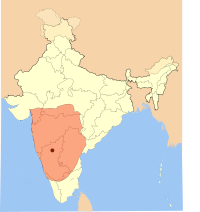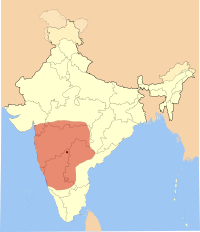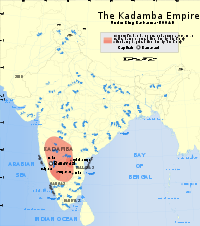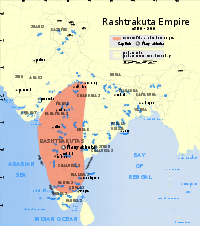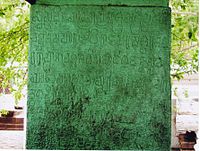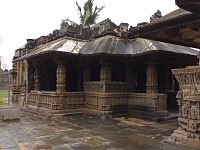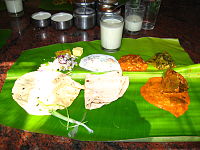- North Karnataka
-
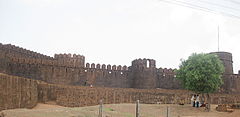 Mirjan Fort in Uttara Kannada district
Mirjan Fort in Uttara Kannada district
North Karnataka (Kannada: ಉತ್ತರ ಕರ್ನಾಟಕ) is an arid plateau from 300 to 700 metres (980 to 2,300 ft) elevation in the Karnataka state of southwest India. It is drained by the Krishna River and its tributaries the Bhima, Ghataprabha, Malaprabha, and Tungabhadra. North Karnataka lies within the Deccan thorn scrub forests ecoregion, which extends north into eastern Maharashtra.
It includes the districts of Belgaum, Bijapur, Bagalkot, Bidar, Bellary, Gulbarga, Yadagiri, Raichur, Gadag, Dharwad, Haveri, Koppal and Uttara Kannada District. Major cities in the region include Hubli, Dharwad, Belgaum, Bellary, Bijapur, Gulbarga, Bidar, Gokak and Karwar.
Overview
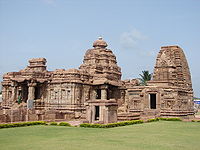 Mallikarjuna and Kashi Vishwanatha temples at Pattadakal
Mallikarjuna and Kashi Vishwanatha temples at Pattadakal
North Karnataka is known for its freedom fighters, social reformers, Hindustani musicians and figures in literature, law, science and technology. It has many Jain monuments from the Kadambas, Rashtrakutas, Badami Chalukyas, Kalyani Chalukyas, Sevuna and Vijayanagara periods (Karnataka Through Centuries).[1] Aihole is known as the cradle of Hindu rock architecture with over 125 temples and monuments, including Rashtrakuta monuments at Lokapura, Bilgi and Kuknur; Kalyani Chalukyas monuments built in the Gadag style at Lakkundi, Gadag and the Koppal District and the Vijayanagar empire temples at Vijayanagara. Badami Chalukyas monuments at Pattadakal, Aihole, and Badami are also well-known. Hampi, in the Bellary District, has some 54 World Heritage monuments and 650 national monuments.
History
 Center of Western Chalukya architectural activity in modern Karnataka , India
Center of Western Chalukya architectural activity in modern Karnataka , India Main articles: History of Karnataka and Timeline of Karnataka
Main articles: History of Karnataka and Timeline of KarnatakaPrehistoric period
North Karnataka's history[2][3] and culture date back to prehistoric times. The earliest Stone Age find in India was a hand ax at Lingasugur, in Raichur district. Sangankal Hills in the Bellary district, which is known as the earliest village settlement of South India,[4] dates back to the Neolithic period. Iron weapons from 1200 BC, found at Hallur in Dharwad district, demonstrate that North Karnataka used iron earlier than northern India.[5] Prehistoric sites in North Karnataka include rock shelters in Bellary, Raichur and Koppal districts with red paintings[6] which include figures of wild animals. The paintings are done in such a way that the walls of caves are not facing northwest, so the northwest monsoon does not affect them. These rock shelters are found at Kurgod, Hampi in Bellary district and Hire Benakal, near Gangavati in the Koppal district. Burial chambers using granite slabs (known as dolmens) are also found; the best examples are the dolmens of Hire Benakal and Kumati in Hadagali Taluk.
Vibhuthihalli at Shahapur Taluk in the Yadgir district, an Archeological Survey of India ancient astronomy site, was created with megalithic stones. The stones, arranged in a square pattern with astronomical significance,[7] cover an area of 12 acres (4.9 ha). Ashoka's stone edicts, found in the state, indicate that major parts of Northern Karnataka were under the Mauryas. Many dynasties left their imprint upon the development of North Karnatakan art, among them the Chalukyas, the Vijayanagara Empire and the Western Chalukyas.
For more information, see Kanaganahalli, Sannati and Maski.Chalukyas
Main articles: Chalukya dynasty and Western Chalukya EmpireChalukya rule is important in the development of architecture known as Karnata Dravida. Hundreds of monuments built by the Chalukyas are found in the Malaprabha river basin (mainly in Aihole, Badami, Pattadakal and Mahakuta, in Karnataka). They ruled an empire extending from the Kaveri in the south to the Narmada in the north. The Badami Chalukya dynasty was established by Pulakesi I in 543; Vatapi (Badami) was the capital.[8] Pulakesi II was a popular emperor of the Badami Chalukya dynasty. He defeated Harshavardhana on the banks of the Narmada river, and defeated Vishnukundins in the south. Vikramaditya I, known as Rajamalla and for building temples, engraved a Kannada inscription on the victory pillar at the Kailasanatha Temple. Kirtivarman II was the last Badami Chalukya king, overthrown in 753 by the Rashtrakuta King Dantidurga.
The Western Chalukya dynasty is sometimes called the Kalyani Chalukyas, after its regal capital at Kalyani (today's Basavakalyan in Karnataka) or the Later Chalukya from its theoretical relationship to the sixth-century Badami Chalukyas. The Western Chalukyas (Kannada: ಪಶ್ಚಿಮ ಚಾಲುಕ್ಯ ಸಾಮ್ರಾಜ್ಯ) developed an architectural style (also called Gadag style) known today as a transitional style, an architectural link between the early Chalukya Dynasty[9] and the later Hoysala empire. The Chalukyas built some of the earliest Hindu temples in India. The best-known examples are the Mahadeva Temple (Itagi) in the Koppal District; the Kasivisvesvara Temple at Lakkundi in the Gadag District and the Mallikarjuna Temple at Kuruvatti and the Kallesvara Temple at Bagali, both in the Davangere District. Monuments notable for craftsmanship are the Siddhesvara Temple at Haveri in the Haveri District, the Amrutesvara Temple at Annigeri in the Dharwad District, the Sarasvati Temple in Gadag, and the Dodda Basappa Temple at Dambal (both in the Gadag district). Aihole was an experimental base for architectural creation.
Kadambas
Main article: Kadamba DynastyThe Kadambas (Kannada: ಕದಂಬರು) were an ancient dynasty of South India who primarily ruled the region which is the present-day Goa state and the nearby Konkan region (part of modern Maharashtra and Karnataka state). The early rulers of this dynasty established themselves at Vaijayanti (or Banavasi) in 345 AD and ruled for more than two centuries. In 607, the Chalukyas of Vatapi sacked Banavasi, and the Kadamba kingdom was incorporated into the expanding Chalukyan empire. In the eighth century, the Chalukyas were overthrown by the Rashtrakutas, who ruled until the 10th century. In 980, descendants of the Chalukyas and Kadambas revolted against the Rashtrakutas; the Rashtrakuta empire fell, resulting in the establishment of a second Chalukyan dynasty (known as the Western Chalukyas). Chatta Deva, a member of the Kadamba family who helped the Western Chalukyas in this coup, re-established the Kadamba dynasty. He was primarily a vassal of the Western Chalukyas, but his successors enjoyed considerable independence and were well-placed in Goa and Konkan until the 14th century. The successors of Chatta Deva occupied both Banavasi and Hangal, and are known as the Kadambas of Hangal. Later, the Kadambas paid nominal allegiance to the other major powers of the Deccan Plateau (such as the Yadavas and Hoysalas of Dorasamudra) and maintained their independence. Four families of Kadambas ruled in southern India: the Kadamba of Hangal, Goa, Belur and Banvasi.[10]
Rashrakutas
Main article: Rashtrakuta DynastyDuring the rule of Dantidurga, an empire was built with the Gulbarga region in modern Karnataka as its base. This clan came to be known as the Rashtrakutas of Manyakheta (Kannada: ರಾಷ್ಟ್ರಕೂಟ), who rose to power in 753.[11][12] During their rule, Jain mathematicians and scholars contributed important works in Kannada and Sanskrit. Amoghavarsha I was the best-known king of this dynasty and wrote Kavirajamarga, a landmark Kannada work. Architecture reached a high-water mark in the Dravidian style, the best examples of which are seen in the Kailash Temple at Ellora, the sculptures of Elephanta Caves in modern-day Maharashtra and the Kashivishvanatha and the Jain Narayana Temples at Pattadakal in modern North Karnataka (all of which are UNESCO World Heritage Sites). Scholars agree that the kings of the imperial dynasty in the eighth to tenth century made the Kannada language as important as Sanskrit. Rashtrakuta inscriptions appear in both Kannada and Sanskrit, and the kings encouraged literature in both languages. The earliest existing Kannada literary writings are credited to their court poets and royalty. Kailash Temple is an example of Dravidian art. This project was started by Krishna I (757–773) of the Rashtrakuta dynasty which ruled from Manyakheta in modern Karnataka. It is located 40 km from the city of Manyakheta (modern Malkhed), on the banks of the Kagini River in Gulbarga district.
Carnatic expansion
Main article: Carnatic expansionVijayanagara empire
Main article: Vijayanagara empireVijayanagara[13][14] (Karnata Empire, or Karnataka Empire) is considered the greatest medieval Hindu empire and one of the greatest in the world at that time. It fostered the development of intellectual pursuits and the fine arts. Abdur Razzaq (the Persian ambassador) said, "The eye of the pupil has never seen a place like it and the ear of intelligence has never been informed that there existed anything to equal it in the world".
Deccan Sultanates
The Vijayanagara Empire, with its capital at Hampi, fell victim to the army of the Deccan Sultanates[15] in 1565. As a consequence of this, Bijapur became the most important city of the region. It is a land of monuments; perhaps no other city except Delhi has as many monuments as Bijapur. Bahmani Shahis and Adil Shahis (Bahmani Sultanate) of Bijapur have played an important role in the history of Karnataka with their contributions to art and architecture and their propagation of Islam in the state. The Bidar Sultanate was part of the Deccan sultanates, which were founded by Qasim Barid.
Minor dynasties
- Chutus of Banavasi (vassal to the Satavahanas)
- Rattas of Saundatti (of Belgaum)
- Guttas of Guttal (Dharwad region)
- Sendrakas of Nagarkhanda (Banavasi province)
- Sindas of Yalaburga (Bijapur-Gulbarga)
- Kadambas of Hangal
Other kingdoms
- Kishkindha
- Karnata Kingdom
- Mauryas
- Shatavahana dynasty (until early third century CE)
- Seuna Yadavas of Devagiri, 9th–14th century
- Ratta dynasty
- Kalachuri, 12th century
- Kampili, 13th century
- Sangama Dynasty
- Saluva Dynasty
Inscriptions
- Mahakuta Inscriptions, Mahakuta Mahakutesvara temple Pillar inscription
- Aihole inscription
- Badami inscriptions
- Kappe Arabhatta inscription
- Itagi Mahadeva Temple Inscription
- Lakkundi inscriptions
- Gadag inscription
- Halasi inscriptions
For more information, see People associated with the study of Kannada inscriptions.North Karnataka historical sites
Main article: List of North Karnataka historical sitesPrincely states
The following are the princely states of British India:
- Mudhol State
- Sandur (princely state)
- Savanur State
- Ramdurg State
- Jamkhandi State, Kundgol
- Kittur
- Shorapur
- Gurgunta
- Kannada-speaking Hyderabad State
- South Kannada-speaking Bombay state
Battles
- Chalukya Pallava Wars
- Battle of Talikota
- Battle of Gajendragad
- Battle of Raichur
- Chola-Chalukya wars
Historic capitals
- Vaijayanti (Banavasi in Uttara Kannada district) - Kadamba dynasty
- Palashika (Halasi, or Halsi, or Halshi in Belgaum district) - Kadamba of Halasi
- Hanungal, or Panungal (Hangal in Haveri district) - Kadambas of Hangal
- Aihole in Bagalkot district - First capital of Badami Chalukyas
- Vatapi (Badami in Bagalkot district) - Badami Chalukyas
- Pattadakal in Bagalkot district - Briefly third capital of Badami Chalukyas
- Mayurkhandi in Bidar district - First capital of Rashtrakuta dynasty
- Manyakheta (Malkhed in Gulbarga district) - Rashtrakuta dynasty
- Kalyani (Basava Kalyana in Bidar district) - Western Chalukyas
- Kundal (Kundal village near sangli in Sangli district) - Western Chalukyas
- Annigeri in Dharwad district - Western Chalukyas (last capital of the Chalukyas)
- Sudi in Gadag district - Coin mint and capital of Western Chalukyas
- Lakkundi in Gadag district - Coin mint of Western Chalukyas
- Vijayanagara (Hampi in Bellary district) - Vijayanagara Empire
- Gulbarga - Bahamani Sultanate
- Bidar - Bahamani Sultanate
- Bijapur - Adil Shahi dynasty (Bijapur Sultanate)
Architectural styles
Main article: Architecture of KarnatakaTrikuteshwara temple complex at Gadag-Betageri, North Karnataka
North Karnataka has contributed to various styles of Indian Architecture during the rule of the Kadamba, Badami Chalukyas, Western Chalukya, Rashtrakuta and Vijayanagara empires:
- Vesara style
- Badami Chalukya architecture
- Gadag style of architecture
- Rashtrakutas style of architecture
- Vijayanagara Architecture
- Kadamba architecture
- Bijapur style
- Keladi Nayaka style
History of Kannada language
Main article: Linguistic history of India#Origins of KannadaKannada is one of the oldest Dravidian languages, with an age of at least 2,000 years. The spoken language is said to have separated from its proto-Dravidian source later than Tamil, and at about the same time as Tulu. However, the archaeological evidence indicates a written tradition for this language of around 1,500–1,600 years. The initial development of Kannada is similar to that of other Dravidian languages and independent of Sanskrit. In later centuries, Kannada has been greatly influenced by Sanskrit in vocabulary, grammar and literary style.
As for the Dravidian race, the Monier-Williams Sanskrit Dictionary lists for the Sanskrit word draviḍa a meaning of a "collective name for Karnatakas, Gurjaras, Kannadigas and Mahārāstras".[16] North Karnataka has its own dialect of Kannada.
- Old Kannada literature
- Kadamba script, Halegannada
- Chalukya Literature
- Kannada literature in the Western Chalukya Empire
- Rashtrakuta literature, Asaga, Amoghavarsha I, Kavirajamarga
- Extinct Kannada literature
- Kappe Arabhatta inscription at Badami
- Adikavi Pampa, Sri Ponna, Ranna
- Medieval Kannada literature
- Kannada literature in Vijayanagara empire
- Vachana sahitya, Basavanna, Akka Mahadevi
- Kumaravyasa, Karnata Bharata Kathamanjari (Mahabharata in Kannada)
Unification of Karnataka
Main article: Unification of Karnataka- The role of North Karnataka in Unification of Karnataka
- Unification of Karnataka and Vidyavardhaka Sangha
- Unification of Karnataka and Aluru Venkata Rao
- The Belgaum Conference of 1924
- Liberation of Kalyana Karnataka (Hyderabad-Karnataka)
For more information, see Revolt of Halagaliya Bedaru and Hyderabad-Karnataka Liberation Day.Festivals
In Kannada, utsava means "festival". The following are festivals celebrated in North Karnataka:
- Kadamba
- Chalukya
- Pattadakal
- Hampi
- Lakkundi
- Kittur
- Bidar
- Dharwad
- Navaraspur Utsava (Bijapur)
- Sawai Gandharva Festival Kundgol
- Vishwa Kannada Sammelana at Belagavi
Tourism
Main article: Tourism in North KarnatakaTemples of North Karnataka
Chandramouleshwara Temple, Hubli Main article: Temples of North Karnataka
Main article: Temples of North KarnatakaThe temples of North Karnataka may be categorised as historical or modern.
World Heritage Sites
- Hampi[17]: Near Hospet in Bellary district
- Pattadakal[18]: Near Badami in Bagalkot district
Notable people of North Karnataka
Main articles: Notable people of North Karnataka and List of people from Hubli DharwadUniversities and other educational institutions
- VTU Visvesvaraya Technological University [1]
- Rani Chennamma University Belgaum
- Karnataka Law University[19] Hubli [2]
- Central University of Karnataka [20] Gulbarga [3]
- Hampi, Kannada University [4]
- Karnatak University Dharwad [5]
- Gulbarga University Gulbarga [6]
- Karnataka State Women University, Bijapur [7]
- University of Agricultural Sciences, Dharwad [8]
- University for Agricultural Sciences, Raichur
- University of Horticultural Sciences (UHS), Bagalkot
- Karnataka Veterinary, Animal and Fisheries Sciences University Bidar [9]
- Gangubai Hangal Gurukul Unkal Hubli-Dharwad
- KLE University Belgaum [10]
- Institute of Information Technology Hubli-Dharwad (IIIT-HD), IT Park Hubli [11]
- B.V.B. College of Engineering and Technology Hubli
- S.D.M College of Engineering & Technology, Dharwad. [12]
- Karnatak Science College Dharwad
- Karnatak College, Dharwar
- Basaveshwra Engineering College, Bagalkot [13]
- BLDEA's Medical college,Hospital & Research Center Bijapur [14]
- BLDEA's Dr P. G. Halakatti College of Engineering & Technology Bijapur [21]
- S.T.J. Institute of Technology Ranebennur [15]
- Karnataka Institute of Medical Sciences
- Vijayanagara Institute of Medical Sciences Bellary
- SDM college of Dental Sciences Dharwad
- Kittur Rani Channamma International Residential Sainik School
- Sainik School Bijapur
- J.T College, Gadag
- Dr. Gangubai Hangal Gurukul - learn Hindustani classical music in Guru Shishya tradition
For more information, see List of educational institutions in Dharwad.Hindustani music
The golden era of Hindustani music in North Karnataka began with the rise to fame of five vocalists: Mallikarjun Mansur, Gangubai Hangal, Kumar Gandharva, Bhimsen Joshi and Basavaraj Rajguru. These five not only contributed to Hindustani classical music, but also left behind a large number of students. Other vocalists include Narayanrao Mujumdar, Ganpatrao Gurav and Mrityunjaya Puranikmath; and Kagalkarbua, Utturkarbua, Uma Maheshwarbua, Pandit Rajwade, Sangmeshwar Gurav, Pandit R N Joshi and Pandit Rambhau Vijapure from Belgium. These vocalists were immensely talented and contributed tremendously.
Karnataka Gandharvas
There are many gandharvas (masters)[22] in Indian Classical Music, including Sawai Gandharva, Kumar Gandharva, Bhoo Gandharva, Swar Raj Chhota Gandharva, Bal Gandharva, Dev Gandharva, Maharashtra Gandharva and Anand Gandharva.
Sawai Gandharva
Rambhau Kundgolkar was born in Kundgol, Karnataka, 15 km from Hubli on the Banglore Hubli Railway route. He was a disciple of Ustad Abdul Karim Khan of Kirana Gharana. The contribution of Sawai Gandharva to Indian classical music is by encouraging disciples such as Pandit Bhimsen Joshi, who was inspired to create Santwani from Sawai Gandharva's bhajans. His other disciples are Dr. Gangubai Hangal, Sangameshwar Gurav and Pandit Firoz Dastur. The Sawai Gandharva Sangeet Samaroh was held at his birthplace of Kundgol. The kirana gharana tradition has been continued by Madhava Gudi of Dharwad, preeminent kirana gharana vocalist.
Kumar Gandharva
Kumar Gandharva has composed ragas such as Madh Surja, Chaiti Bhoop, Gandhi Malhar and several bandishes. Geet Varsha and Mala Umajalele Bal Gandharva are also his compositions. He did not accept the rigidity of the Gharana form.[citation needed]
Shivaputra Sidhharamaiya Komkali was born to a Lingayat family in Sulebhawi (near Belgaum), and imitated many singers during his childhood. At age eight, he went to Bombay and lived with Dr. B. R. Devdhar at his Deaodhar's Indian Music School near the Opera House; there he received his musical education and heard many singers, including Ustad Bade Gulam Ali Khan and Shine Khan. At a young age, he had a lung problem and had to change his gayaki singing style. He was not allowed to sing for two years; his first baithak took place at Puna where he sang well for an hour, with no adverse effects.
Arts and crafts
- Kasuti embroidery: putting stitches by hand on dresswear like Ilkal sarees, especially done by Lambanis of Bellary and Dharwad district
- Bidriware: metal handicraft originated in Bidar during the rule of the Bahamani Sultans
- Kinhal Crafts: originated in Kinhal (Kinnal) in Koppal district. Crafts are mainly toys, wood carvings and mural paintings.
Folk dances
- Dollu Kunitha is a popular drum dance. The large drums are decorated with coloured cloth, and slung around the necks of men. The dances are accompanied by songs of religious praise or war.
- Veeragase is a popular folk dance, a symbolic presentation of the heroism and valour of the god Veerabahadhra. Its exponents are called Lingadevaru; they perform the dance with religious fervour at festival time, especially during the months of Shravana and Kartika.
- Nandikolu kunitha is an art form of male devotees of Lord Siva. The Nandi pole is about 18 cubits long, each cubit representing a dharma. The length of the pole is fitted with brass pots and plates, and an ornate silver or brass umbrella at the top with a silk tassel (which is the flag). The performer (on a sling) balances the pole; this requires skill and strength. The sight of the devotee's inspired dance, to the background beat and the resulting symphony of sounds from the pots and plates on the pole, is impressive.
- Jodu halige are percussion instruments used by two artists to produce rhythmic notes of energy and power. Their movements along the stage (expressive of their physical energy) harmonize with the notes produced by the instrument. The Haligi (wood), circular in shape, is made of buffalo hide, and a short stick is used on it. The notes, combined with the bodily movement, are pleasing to an audience.
- Lambani nruthya Lambani women, dressed colourfully, move in a circle with clapping and singing. This dance is uncommon, and performed primarily for important festivals.
- Veerabhadra kunitha depicts the story of Veerabhadra, the legendary minor god created by Lord Shiva to teach a lesson to his father-in-law Daksha. Veerabhadra goes to the place of the yagya and disrupts the ceremony.
Textiles
Garag, a small town located 15 km north of Dharwad, was the sole producer of the national flag and the hand-woven khadi for its manufacture. Hubballi Siree produces both silk and cotton sarees, worn by most villegers in North Karnataka and parts of Maharastra. The fabric is primarily woven in Gadag-Betigeri. Bellary has approximately 4,800 families employed in the textile industry.
Natural resources
The Hutti Gold Mine is the only gold-extraction company in India. It operates in Hatti, an ancient gold- mining area about 70 km from Raichur. Tourism is also permitted inside the mine.[23] The Gadag, Koppal and Bellary districts are rich in manganese, gold and iron ore.
Cuisine
Main article: Cuisine of KarnatakaNorthern Karnataka cuisine may be primarily found in the districts of Bidar, Kalburgi, Vijapura, Bagalakote, Belagaavi, Raayachooru, Dharwad, Gadag, Haveri, Koppala and parts of Ballari.
Wheat and jowar rottis (unleavened bread made with millet) are popular.
The following are typical items in a vegetarian Northern Karnataka meal:
- Rotti/Bhakri, Rice, Saaru, Happala and kosambari
- Badane kaayi gojju/enne-gai/tumbu-gai - Stuffed and/or sauteed
- Shenga/Ellu – Dry chutney in powder form, sometimes called HinDi (nothing to do with the Hindi language); kempu khaara - hot chutney paste made with red chillies, eaten as a condiment
- Bele palya - cooked split or whole beLe, chana, moong with greens such as methi, spinach or spring onion
- mosaru bajji or raitha - salad with Mosaru and majjige, beNNe or tuppa.
- Raw salads - made with spring onion, onion, green chilli or methi leaves, sometimes with oggaraNe of sasive and/or jeerige
- Dharwad pedha – Hubli-Dharwad is known for its dharwad pedha (a milk-based sweet), Mirchi Bhaji
and girmit made with murmure (a rice dish).
Festivals and associated foods
- Sankranti (January – harvest festival): Madeli, holige of gingelly seeds, Bengal gram dal and ground nut; jawar roti, bajra roti, bharta, chutney powders of niger, linseed and ground nut
- Shivarathri (February/March - eaten after a day’s fast): Godhi huggi, allittu, Bengal gram usali, moth bean usali and holige
- Holi (March - destruction of evil): holige, jowar wade, pumpkin gargi (some groups prepare a nonvegetarian curry)
- Ugadi (April/May - Kannadiga new year): holige, karigadabu, vermicelli payasam, bevu bella and godhi huggi
- Basava Jayanti (May - birthday of Basava): holige, karigadabu and mango shikarane
- Karahunnive (June - bullock-worship): holige, karigadabu, jawar wade, pumpkin gargi, kodabale and mango shikarane.
- Mannettina Amavasye (June - clay-bullock worship): karigadabu, holige, jawar wade, sajjaka, pumpkin gargi and vermicelli payasam
- Naga Panchami (July - cobra-worship): laddu of semolina, bunde, besan, sev, groundnuts, gingelly seeds, gulladki, puffed jowar, kuchagadabu, allittu, Bengal gram usali, moth bean usali, bajra and jowar rotis
- Ganesh Chaturthi (August - Ganesha-worship): godhi huggi, holige, modaka, vermicelli payasam, sajjaka, jawar roti, mesta bhaji, rice curds, panchakajjaya, karigadabu and gudagana huggi
- Dasara/Mahanavami (September - Durga puja): holige, karigadabu, sajjakada holige, sajjaka, durga puja taraga, foxtail millet holige, karachikayi, pumpkin gargi and jowar wade
- Shigehunnive (October - farmers' festival, worship of standing crop): foxtail millet holige, chakli, akki huggi, kodabale, holige, karigadabu, undigadabu, kuchchida khara, bhaji of capsicum, cluster beans, pumpkin; chutney powders of niger, linseed and ground nut (some communities prepare a nonvegetarian curry)
- Deepavali (October - Lakshmi puja): holige, karigadabu, karachikayi, laddu of semolina, besan and sajjakada holige[24]
Religion
Buddhism
Main article: Buddhism in North KarnatakaBuddhism in North Karnataka dates from the third to the first centuries BC. Sannati and Kanaganahalli are two important excavation sites, and there is a Tibetan Buddhist colony at Mundgod.
Jainism
Main article: Jainism in North KarnatakaMadhwas
Madhwas are the followers of Madhwacharya, the proponent of Dwaita philosophy.
Lingayats
The followers of Basava, chief proponent of Shaivism in Karnataka, are known as Lingayats.
See also
- South Karnataka
- Chalukya
- Western Chalukya Architecture
- Western Chalukya
- Vijayanagar Architecture
- Dravidian architecture
- Badami Chalukya Architecture
- Tourism in North Karnataka
- Bayaluseemae
- Siddis of Karnataka
- Family names in North Karnataka
- Movies shot in North Karnataka
- Shilahara used Kannada as official language
References
- ^ Karnataka Through the Centuries Retrieved 2011-07-12.
- ^ "Handbook of Karnataka, History". http://www.gazetteer.kar.nic.in/get_chap.asp. Retrieved 2008-08-11.
- ^ "The Chalukyan magnificence". http://www.hinduonnet.com/fline/fl2201/stories/20050114000106500.htm. Retrieved 2008-08-11.
- ^ "Ambitious plan for South India’s oldest village". The Hindu (Chennai, India). http://www.hindu.com/2009/02/18/stories/2009021852280300.htm. Retrieved 2008-08-11.
- ^ "History of Karnataka". http://www.karnataka.com/history. Retrieved 2011-06-14.
- ^ "Granite in The Service of Man - Through The Ages". http://www.worldstonex.com/en/InfoItem.asp?ICat=2&ArticleID=275. Retrieved 2010-10-27.
- ^ "ASI begins work to protect ancient monument". Times of India. http://articles.timesofindia.indiatimes.com/2011-01-20/hubli/28379400_1_ancient-monument-asi-stones. Retrieved 2011-06-14.
- ^ "Chalukyas of Badami". http://www.kamat.com/kalranga/deccan/chalukya/index.htm. Retrieved 2010-10-27.
- ^ "CHALUKYA DYNASTY". http://www.uq.net.au/~zzhsoszy/ips/misc/chalukya.html. Retrieved 2008-08-11.
- ^ "Kadamabas of Hangal". http://www.prabhu.50g.com/southind/kadamba/south_kadambahcat.html. Retrieved 2008-08-11.
- ^ "Kamat's Potpourri: The Rashrakutas". http://www.kamat.com/kalranga/deccan/rashtrakutas/. Retrieved 2008-08-11.
- ^ "OurKarnataka.com: History of Karnataka: The Rashtrakutas:". http://www.ourkarnataka.com/states/history/historyofkarnataka22.htm. Retrieved 2008-08-11.
- ^ "OurKarnataka.com: History of Karnataka: Vijayanagar Empire". http://www.ourkarnataka.com/states/history/historyofkarnataka47.htm. Retrieved 2008-08-11.
- ^ "History of Vijayanagara". http://www.hampi.in/history.htm. Retrieved 2008-08-11.
- ^ "Islamic Art of the Deccan". http://www.metmuseum.org/toah/hd/decc/hd_decc.htm. Retrieved 2008-08-11.
- ^ "Dravidian languages, Kannada". http://webapps.uni-koeln.de/cgi-bin/tamil/recherche. Retrieved 2008-08-11.
- ^ "Group of Monuments at Hampi - UNESCO World Heritage Centre". http://whc.unesco.org/en/list/241. Retrieved 2008-08-11.
- ^ "Group of Monuments at Pattadakal - UNESCO World Heritage Centre". http://whc.unesco.org/en/list/239. Retrieved 2008-08-11.
- ^ "Law varsity's first VC takes charge". http://archive.deccanherald.com/Content/Jan132009/state20090112112186.asp. Retrieved 2009-01-13.
- ^ "Central varsity to function from August". The Hindu (Chennai, India). 2009-03-17. http://www.hindu.com/2009/03/17/stories/2009031751940300.htm. Retrieved 2009-03-17.
- ^ http://www.bldea.org/domains/technology/
- ^ "There are many Gandharvas in the Indian Classical Music". http://kavitha.weblogs.us/archives/033786.html. Retrieved 2008-08-25.
- ^ "Striking it rich: Hutti gold mines on expansion spree". The Hindu (Chennai, India). 2008-11-28. http://www.hindu.com/2008/11/28/stories/2008112851740600.htm. Retrieved 2008-11-28.
- ^ "Major festivals and associated traditional foods" (PDF). http://www.krepublishers.com/02-Journals/JHE/JHE-18-0-000-000-2005-Web/JHE-18-1-000-000-2005-Abst-PDF/JHE-18-1-043-048-2005-1275-Inamdar-V/JHE-18-1-043-048-2005-1275-Inamdar-V-Full-Text.pdf. Retrieved 2008-08-25.
Categories:- Culture of Karnataka
- Regions of Karnataka
- History of Karnataka
- Regions of India
- Karnataka
Wikimedia Foundation. 2010.

